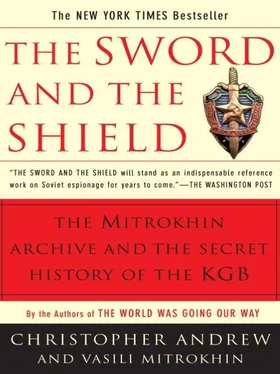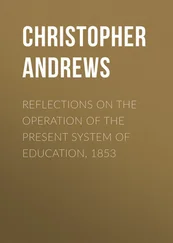In the spring of 1927 there were dramatic revelations of Soviet espionage in eight different countries. In March a major OGPU spy ring was uncovered in Poland; a Soviet trade official was arrested for espionage in Turkey; and the Swiss police announced the arrest of two Russian spies. In April a police raid on the Soviet consulate in Beijing uncovered a mass of incriminating intelligence documents; and the French Sûreté, arrested members of a Soviet spy ring in Paris run by Jean Crémet, a leading French Communist. In May Austrian foreign ministry officials were found passing classified information to the OGPU residency, and the British Home Secretary indignantly announced to the House of Commons the discovery of “one of the most complete and one of the most nefarious spy systems that it has ever been my lot to meet.” 68
Following this last discovery, Britain—still regarded in the Soviet Union as the leading world power and its most dangerous enemy—formally broke off diplomatic relations, and senior ministers read out to the Commons decrypted extracts from intercepted Soviet telegrams. To tighten the security of Soviet diplomatic and OGPU communications after the dramatic revelation of British codebreaking successes, the laborious but virtually unbreakable “one-time pad” cipher system was introduced. As a result, Western cryptanalysts were able to decrypt almost no further high-grade Soviet communications until after the Second World War. 69
THE MOST WORRYSOME as well as the most plentiful foreign intelligence in 1927 concerned Japan. Since 1925 INO had been able to intercept the secret communications of both Japan’s military mission and its consulate-general in the northeast Chinese city of Harbin. Remarkably, instead of using diplomatic bags and their own couriers, Japanese official representatives in Harbin corresponded with Tokyo via the Chinese postal service. The OGPU recruited the Chinese employees who were used to take Japanese official despatches to the Harbin post office, and sent expert teams of letter-openers to examine and photograph the despatches, before sending them on their way in new envelopes with copies of Japanese seals. Professor Matsokin, a Japanese specialist from Moscow, 70was employed by INO in Harbin to peruse the despatches and send translations of the most important promptly to the Centre. There was ample evidence in the intercepts forwarded to Moscow of designs by the Japanese military on China and the Soviet Far East. But the most troubling document, intercepted in July 1927, was a secret memorandum written by Baron Gi-ishi Tanaka, the Japanese prime minister and foreign minister, which advocated the conquest of Manchuria and Mongolia as a prelude to Japanese domination over the whole of China, and predicted that Japan “would once again have to cross swords with Russia.” 71
A second copy of the memorandum was obtained in Japanese-occupied Korea by the residency at Seoul, headed by Ivan Andreevich Chichayev (later wartime resident in London). A Japanese interpreter, codenamed ANO, recruited by the INO residency, succeeded in extracting the document, along with other secret material, from the safe of the Japanese police chief in Seoul. 72A copy of the Tanaka memorandum was later leaked by INO to the American press to give the impression that it had been obtained by an agent working for the United States. 73As recently as 1997 an SVR official history continued to celebrate the simultaneous acquisition of the memorandum in Harbin and Seoul as “an absolutely unique occurrence in intelligence operations.” 74Though somewhat exaggerated, this judgment accurately reflects the enormous importance attached at the time to the discovery of Tanaka’s prediction of war with Russia.
The acute anxiety in Moscow caused by the breach of diplomatic relations with Britain and the apparent threat from Japan was clearly reflected in an alarmist article by Stalin, published a few days after he received the Tanaka memorandum:
IT IS HARDLY open to doubt that the chief contemporary question is that of the threat of a new imperialist war. It is not a question of some indefinite and immaterial “danger” of a new war. It is a matter of a real and material threat of a new war in general, and war against the USSR in particular. 75
The fact that Constantini had failed to provide anything remotely resembling a British version of the Tanaka memorandum did not lead either Stalin or the conspiracy theorists of the Centre to conclude that Britain had no plans to attack the Soviet Union. They believed instead that greater efforts were required to penetrate the secret councils of the Western warmongers. Stalin, who had emerged as the clear victor in the three-year power struggle which followed Lenin’s death, demanded more intelligence on the (mostly imaginary) Western plots against the Soviet Union which he was sure existed.
In an effort to make Soviet espionage less detectable and more deniable, the main responsibility for intelligence collection was shifted from “legal” to “illegal” residencies, which operated independently of Soviet diplomatic and trade missions. In later years the establishment of a new illegal residency became an immensely timeconsuming operation which involved years of detailed training and the painstaking construction of “legends” to give the illegals false identities. The largely improvised attempt to expand the illegal network rapidly in the late 1920s and early 1930s, without the detailed preparation which later became mandatory, brought into OGPU foreign operations both unconventional talent and a number of confidence tricksters. Among the secret scandals discovered by Mitrokhin in KGB files was that of the illegal residency established in Berlin in 1927 with the Austrian Bertold Karl Ilk as resident and Moritz Weinstein as his deputy. A later investigation concluded that the Centre should have noted the “suspicious speed” with which the Ilk-Weinstein residency claimed to be expanding its agent network. Within two months it was reporting operations in Britain, France and Poland as well as in Germany. Ilk refused to provide more than sketchy information on his agents’ identity on security grounds. His failure to supply detailed biographies was reluctantly accepted by the Centre, which was still reeling from the widespread unmasking of OGPU networks in the spring of 1927. It gradually became clear, however, that the core of the Ilk-Weinstein illegal network consisted of their own relatives and that some elements of it were pure invention. Its agent operations in Britain and France were discovered to be “plain bluff,” though an effective way of obtaining funds from the Centre for Ilk and Weinstein. The network in Germany and Poland, while not wholly fictitious, was under surveillance by the local police and security services. The Centre closed down the entire residency in 1933, though without attracting the publicity occasioned by the intelligence failures of 1927. 76
THE MAIN INFLUENCE on the evolution of the OGPU and its successors during the Stalinist era was the change in the nature of the Soviet state. Much of what was later called “Stalinism” was in reality the creation of Lenin: the cult of the infallible leader, the one-party state and a huge security service with a ubiquitous system of surveillance and a network of concentration camps to terrorize the regime’s opponents. But while Lenin’s one-party state left room for comradely debate within the ruling party, Stalin used the OGPU to stifle that debate, enforce his own narrow orthodoxy and pursue vendettas against opponents both real and imagined. The most vicious and long-lasting of those vendettas was against Leon Trotsky, Lenin’s former Commissar for War.
In its early stages at least, the OGPU’s campaign against Trotsky and his supporters was characterized by a bizarre combination of brutality and farce. When Trotsky refused to recant and admit his “crimes against the Party,” he was sent into internal exile at Alma-Ata, a town in a remote corner of Kazakhstan on the Chinese border. The OGPU detachment which came to his Moscow flat on the morning of January 17, 1928 to take him into exile found Trotsky still in his pajamas. When he refused to come out, the OGPU broke down the door. Trotsky was surprised to recognize the officer leading the detachment as one of his former bodyguards from the civil war. Overcome with emotion at the sight of the ex-Commissar for War, the officer broke down and sobbed, “Shoot me, Comrade Trotsky, shoot me.” Trotsky calmed him down, told him it was his duty to obey orders however reprehensible, and adopted a posture of passive resistance while the OGPU removed his pajamas, put on his clothes and carried him to a car waiting to transport him to the Trans-Siberian Express. 77
Читать дальше











